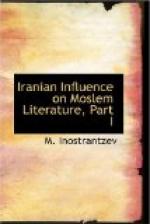[Footnote 1: Ibrahim ibn Muhammad al Baihaki, Kitab al-Mahasin val masavi, herausgegeben von Dr. F. Schwally, Geissen 1902.]
[Footnote 2: Le livre des beautes et des antithesis attribue a Abu Othman Amr ibn Bahr al-Djakiz, texte arabe publie par G. Van Vloten Leyde; 1898.]
[Footnote 3: See the review by Barbier de Meynard of the edition of Mahasin wal Azdad in the Revue Citique, 1900, 276.]
In the Parsi ecclesiastical literature of an ethical nature we find definitely settled what is “proper” and, on the other hand, what is “improper."[1] It is well known that books under this title,—“the proper and the improper” or “the licit and the illicit”—are to be found among the Pahlavi tracts the time of whose composition can be fixed somewhere between the seventh and the ninth centuries A.D.[2] Comparing the Pahlavi tracts with reference to these questions with Arabic books on good and bad qualities and manners, we have to bear in mind the general features, general outline, as well as the conditions of civilisation of the period when these books were written, in other words, the circumstances of their intimate relation generally of a cultural nature, particularly of a literary form obtaining between the Arab and Persian nations, and between Islam and Parsism. Not only in detail, but also in their nature these books must be differentiated in proportion as were different the clergy who wrote these ethical tracts from didactic works of a strong legendary element belonging to the pen of secular people. These literary monuments must be differentiated quite as much as their authors and with reference to them we may institute the same parallel which we suggested above between the Parsi clergy and the Iranophile party of the Shuubiya.
[Footnote 1: Shayed-na-shayed.]
[Footnote 2: Shayast la-shayast West Pahlavi Texts, Part I, 1880. Sacred Books of the East, Vol. V. 237-407.]
Furthermore, associated with these literary features was also that class of Arabic books, so well known and the period of which interests us, the books on Questions and Answers.[1]
[Footnote 1: Kitab al Masael wa Jawabat.]
And this is precisely the form in which some of the better known of the Parsi books have been cast, for instance, the Minog-i-Khrad[1] and the Dadistan[2] The second of these books decidedly belongs to the ninth century. Its contents no doubt, were strongly divergent from others owing to its dependence on altered conditions.
[Footnote 1: Sacred Books of the East, Vol. XXIV, 1-15.]
[Footnote 2: Sacred Books of the East XVIII, 1-277.]
We have already indicated the importance of the citations in early Arabic anthologies incorporated from Persian historical works.[1] This nature of quotations are to be found also in books on “good and bad morals and conduct.” Further we find embedded in Arabic works a considerable amount of matter of great importance, a circumstance of vital moment for the investigation of the survival of Persian literary tradition. A number of passages similar to those found in these books are undoubtedly embodied in various Arabic anthologies. We give below from the two works al Mahasin wal Masavi and al Mahasin wal Azdad extracts bearing on Persian subjects.[2]




